Photo
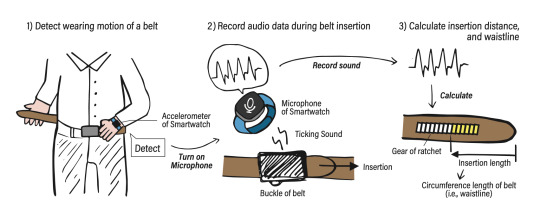
Towards Automatic Waistline Measurement with A Smartwatch
2nd International Conference on Activity and Behavior Computing (ABC '20), Aug 26-29, 2020. Yuki Matsuda and Yugo Nakamura
Abstract: To solve obesity which is one of the causes of lifestyle-related diseases, people first need to know the state of their bodies such as waistline. We have considered that a belt, which people wear every day, can be used for waistline measurement without a burden. Hence, we study a method of automatic waistline measurement in people's daily life using a belt and sensing technologies. In this paper, we propose an acoustic-based automatic waistline measurement method using a common fashion belt and a widespread smartwatch's microphone. Through the preliminary experiments, we discuss the feasibility and technical issues of the proposed method.
Conference (ABC '20): https://abc-research.github.io/
#WaistonBelt#audio data#smartwatch#waistline#healthcare#wearable devices#NAIST#conference#english#publication
0 notes
Photo
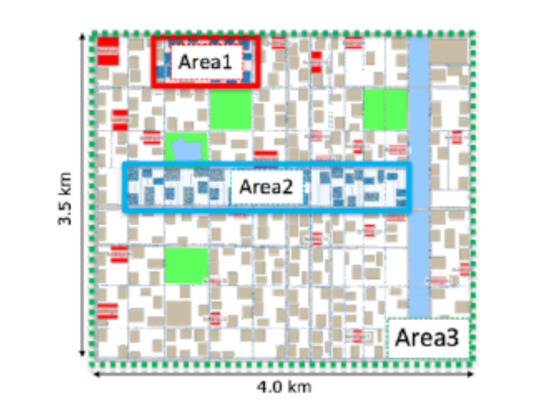
被災者行動の不確実性を考慮した災害弱者のための避難所決定手法の提案
マルチメディア, 分散, 協調とモバイル(DICOMO 2020)シンポジウム論文集, pp.778-784, オンライン, 2020年6月. 田中 智基, 松田 裕貴, 藤本 まなと, 諏訪 博彦, 安本 慶一
概要: 被災者が一斉に最寄りの避難所へ向かうことで,一部の被災者がたらい回しにされる問題がある.収容人数を超過しないように各被災者に避難所を指定したとしても,一部が指示に従わないことで,指定された避難所に到着しても収容人数��達しているため,たらい回しにされることも考えられる.特に,高齢者や身障者など身体能力が原因により避難行動に制限が生じる災害弱者は,健常者よりも多く避難時間を要するため,たらい回しにされる可能性が高く,避難の大幅な遅れを引き起こすことになる.本研究では,災害弱者と指示に従わない被災者の存在を考慮し,各被災者の避難予測時間と避難所の収容可能人数に基づいたナップサック問題を解くことで,被災者の避難先を決定する手法を提案する.具体的には,全ての被災者が最寄りの避難所へ向かった場合のシミュレーションを行い,各避難所に対して被災者の一部が指示に従わず最寄りの避難所に向かう可能性を想定し,各避難所への避難誘導人数に制限を設けた上でナップサック問題を解くことで,災害弱者の避難が遅れるケースの発生を軽減できるようにする.提案手法をマルチエージェントシステムにより評価実験を行った結果,予め想定した割合を超えない場合,災害弱者の平均避難時間を従来手法より短縮することができた.
Conference: http://dicomo.org/
IPSJ DL:
PDF: http://yukimat.jp/data/pdf/paper/EvacuationSimulation_c_202006_tanaka_DICOMO.pdf
0 notes
Photo

観光ナビにおいて必見スポットをよりよい時間帯に訪問可能にするオンサイトプランニング手法
マルチメディア, 分散, 協調とモバイル(DICOMO 2020)シンポジウム論文集, pp.1487-1498, オンライン, 2020年6月. 磯田 祥吾, 日高 真人, 松田 裕貴, 諏訪 博彦, 安本 慶一
概要: 観光経路推薦に関して,既存研究の多くは,次訪問スポットのみの満足度に基づいて推薦しているが,次以降に訪れるスポットを考慮に入れていないため,次スポット以降の観光が制限される.次訪問スポットの満足度と,次訪問スポット以降の期待満足度を考えた場合,この二つにトレードオフ関係が発生する可能性がある.また同一スポットを訪問する際に,訪れる時間帯によって満足度が異なるため,より良い時間帯に訪問することが観光全体の満足度向上につながる.これら2点を考慮した上で,ユーザに観光ルートを提示するのが望ましいが,我々が知る限り,そのようなシステムは存在しない. 本稿では,上記を考慮するため,まず,次スポットの静的観光地コンテキストと動的観光地コンテキスト,次スポット以降に訪問するスポットから得られる期待満足度の3つの要素から成るツアースコアを定式化する.ツアースコアが最大となる観光ルート(次訪問スポットとそれ以降に訪問するスポット群の列)を算出する問題はNP困難であり,オンサイトで準最適解を求めるため,貪欲法をベースとした3つのアルゴリズム:(1) 次スポットのみを考慮した貪欲法,(2) 観光時間全体を考慮した貪欲法,(3) 観光時間全体および探索幅を広げた貪欲法の提案を行う. 提案アルゴリズムの有用性を調査するため,京都市東山区にある20箇所の訪問スポットを対象に3つのアルゴリズムを適用することで,出力解が京都のモデルルートと比較して優位であり,それぞれ1.9±0.1 (s),15.9±0.5 (s),7766.6±8.9 (s)の計算時間で算出できることを確認した.
Conference: http://dicomo.org/
IPSJ DL:
PDF: http://yukimat.jp/data/pdf/paper/TravelNavi_c_202006_isoda_DICOMO.pdf
0 notes
Photo

ドライブレコーダ動画を用いた路上駐停車判定手法の提案
マルチメディア, 分散, 協調とモバイル(DICOMO 2020)シンポジウム論文集, pp.1102-1110, オンライン, 2020年6月. 松田 明大, 松井 智一, 松田 裕貴, 諏訪 博彦, 安本慶一
概要: 近年,禁止区域での路上駐停車が社会問題の一つになっている.特に大都市圏や観光地では,多く の路上駐停車が存在する.また,路上駐停車は渋滞や事故を引き起こす要因ともなりうるため,リアルタ イムな検出により迅速な対応が求められる.先行研究では,定点カメラや過去動画との比較により路上駐 停車の検出が行われた.しかしながら,定点カメラの設置地点のみでの検出や,過去動画の限定的なエリア,処理速度・精度などが問題としてある.本研究では,これらの問題を解決するために,一般に幅広く 普及しているドライブレコーダ動画を用いたリアルタイムな路上駐停車の判定の実現を目指す.そのため に,車載デバイスのみを用いた路上駐停車の特徴に基づいた機械学習による判定手法を提案する.物体検 出モデルである YOLOv3 を用いて動画を解析し,計 1765 台分の Bounding Box の座標情報とその時の自 車情報をもとに,データセットを作成した.そして,ランダムフォレストとロジスティック回帰を用いて モデルを作成し,ホールドアウト法と層化 K-分割検証法により評価を行ったところ,2 つのモデルにおい て,それぞれ F 値が最大 93%,90% となった.この結果により,Bounding Box と自車データを用いた路 上駐停車判定手法の有効性が確認された.
Conference: http://dicomo.org/
IPSJ DL:
PDF: http://yukimat.jp/data/pdf/paper/DriveRecorder_c_202006_matsuda_DICOMO.pdf
0 notes
Photo
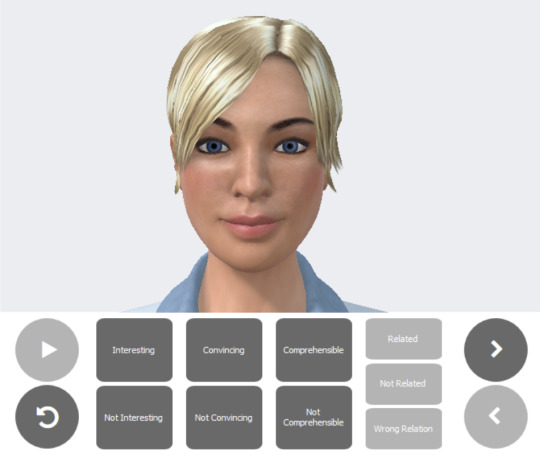
Evaluation of Argument Search Approaches in the Context of Argumentative Dialogue Systems
The 12th International Conference on Language Resources and Evaluation (LREC '20), pp.513-522, Marseille, France, May 11-16, 2020. Niklas Rach, Yuki Matsuda, Johannes Daxenberger, Stefan Ultes, Keiichi Yasumoto and Wolfgang Minker
Abstract: We present an approach to evaluate argument search techniques in view of their use in argumentative dialogue systems by assessing quality aspects of the retrieved arguments. To this end, we introduce a dialogue system that presents arguments by means of a virtual avatar and synthetic speech to users and allows them to rate the presented content in four different categories (Interesting, Convincing, Comprehensible, Relation). The approach is applied in a user study in order to compare two state of the art argument search engines to each other and with a system based on traditional web search. The results show a significant advantage of the two search engines over the baseline. Moreover, the two search engines show significant advantages over each other in different categories, thereby reflecting strengths and weaknesses of the different underlying techniques.
Conference (LREC '20): https://lrec2020.lrec-conf.org/en/
ACL Anthology: https://www.aclweb.org/anthology/2020.lrec-1.65/
PDF: https://www.aclweb.org/anthology/2020.lrec-1.65.pdf
0 notes
Photo

Embedding Additional Behaviors Into Users' Daily Routines for Improving Users' Awareness of Self-Health Condition
15th International Conference on Persuasive Technology (PT '20, BCSS), Aalborg, Denmark, April 20-23, 2020. Zhihua Zhang, Yuki Matsuda, Manato Fujimoto, Yutaka Arakawa and Keiichi Yasumoto
Abstract: Nowadays, lifestyle diseases have become a global social problem. As a treatment, it is necessary to review people's life patterns and lead them to a better lifestyle, which is called ''Behavior Change.'' With the progress of information technology, many pieces of research and developments have been conducted to assist people with their daily life, trying to induce behavior change. The common approach used in the existing systems is altering users' target behaviors to new behaviors, such as drinking more water and walking further. However, this approach considers less about the timing of proposing and the relevance between users' target behaviors and new behaviors, which limits the effectiveness of the existing systems in inducing behavior change. To improve users' experience and effectiveness of the system, in this paper, we propose a new design of behavior change support system which promotes behavior changes by embedding additional behaviors into users' daily routines, trying to improve users' awareness of their health condition.
Conference (PT '20): http://persuasive2020.org/
Conference (BCSS '20): https://bcssworkshop.wordpress.com/
#behavior change#weight scale#microwave#persuation#intervention#NAIST#publication#english#conference#UbiMicrowave
0 notes
Photo
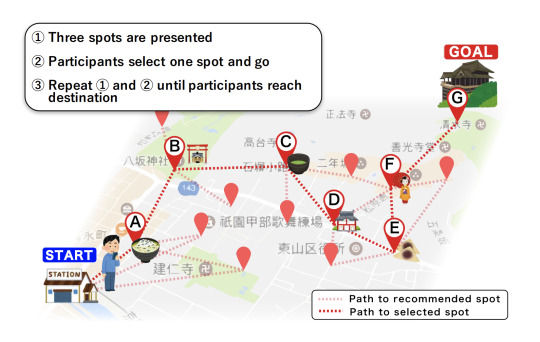
On-Site Trip Planning Support System Based on Dynamic Information on Tourism Spots
Smart Cities 2020, Vol.3, No.2, 2020. Masato Hidaka, Yuki Kanaya, Shogo Kawanaka, Yuki Matsuda, Yugo Nakamura, Hirohiko Suwa, Manato Fujimoto, Yutaka Arakawa and Keiichi Yasumoto
Abstract: Recently, due to the drastic increase in foreign tourists coming to Japan, there has been a demand to provide smart tourism services that enable inbound tourists to comfortably enjoy sightseeing. To provide satisfactory experiences for tourists, it is desirable to provide tourist information in a timely manner by considering dynamic information, which is information that changes over time, such as current congestion information in destination spots and travel route information, in addition to static information, such as the preferences and profiles of tourists. However, in many existing systems, serious problems occur, such as (1) a lack of support for on-site use, (2) a lack of consideration of dynamic information, and (3) heavy burden on tourists. In this paper, we propose a novel system that can provide tourism plans for tourism spots in a timely manner. The proposed system consists of the following two key mechanisms: (A) A mechanism for acquiring preference information from tourists (including preference on dynamic information); (B) a curation mechanism for realizing on-site tourism. To demonstrate the effectiveness of the proposed system, we carried out evaluation experiments utilizing real tourism spots and simulations. As a result, we obtained the following primary findings: (1) On-site tourism spot recommendation is effective for tourists who do not make detailed tourism plans before sightseeing; (2) preference information for participants can be reflected in the tourism spot recommendation while massively reducing the burden on participants; (3) it is possible to obtain a higher satisfaction level than is achieved with model courses, which are often used for sightseeing.
MDPI Smart Cities: https://www.mdpi.com/2624-6511/3/2/13
PDF: http://yukimat.jp/data/pdf/paper/TravelCuration_j_202004_hidaka_mdpiSmartcities.pdf
#sightseeing#recommendation#tour guide#navigation#routing#algorithm#NAIST#english#journal#publication
0 notes
Photo
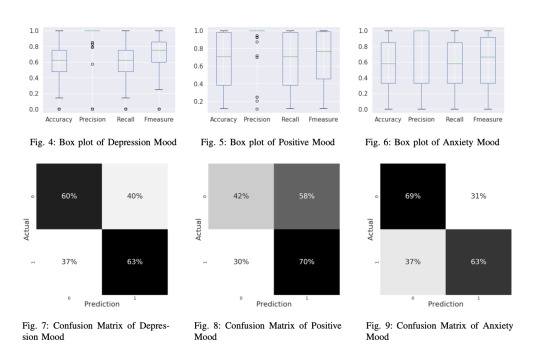
Predicting Depression and Anxiety Mood by Wrist-Worn Sleep Sensor
2020 IEEE International Conference on Pervasive Computing and Communications Workshops (PerCom Workshops '20, WristSense), Texas, USA, March 23-27, 2020. Shuichi Fukuda, Yuri Tani, Yuki Matsuda, Yutaka Arakawa and Keiichi Yasumoto
Abstract: In recent years, researches on recognizing daily behavior and psychological / physiological states have been actively conducted to change the behavior of workers working in companies. In this paper, we analyzed Occupational Health questionnaire named DAMS for waking-up time and daily sleep data that are acquired from wearable devices in 2--3 weeks experiment of 60 office workers working in five general companies. By using a machine learning method, our binary Balanced Random Forest model predicts depression, positive, and anxiety moods in two levels, high and low. As a result of Leave One Person Out cross validation, it was confirmed that our model estimated with the F1 values of depression mood: 0.776, positive mood: 0.610, anxiety mood: 0.756. Moreover, we evaluated the variance of the three estimations among subjects by referencing the box chart. As a result, it was confirmed that there is variance in estimation accuracy for each subject.
Conference (PerCom): http://www.percom.org/
Conference (WristSense): https://sites.google.com/view/wristsense2020
#WorkerSense#DAMS#stress level assessment#mental health#wearable devices#environmental sensor#NAIST#publication#conference#english
0 notes
Photo
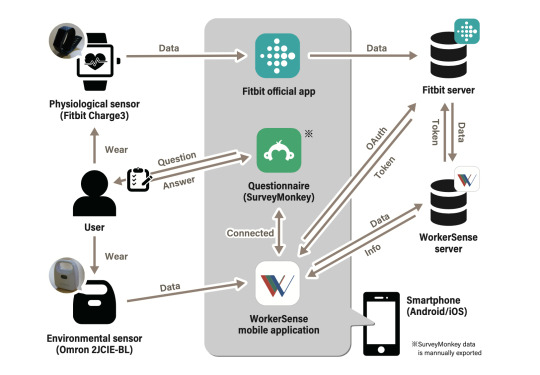
WorkerSense: Mobile Sensing Platform for Collecting Physiological, Mental, and Environmental State of Office Workers
2020 IEEE International Conference on Pervasive Computing and Communications Workshops (PerCom Workshops '20, PerHealth), Texas, USA, March 23-27, 2020. Yuri Tani, Shuichi Fukuda, Yuki Matsuda, Sozo Inoue and Yutaka Arakawa
Abstract: In data collection of the human physiological and psychological conditions for mental healthcare (e.g., work engagement), measurement methods using environment-installed sensors and questionnaire surveys have been often used. However, these approaches are not practical in continuous data collection, due to the large burden for people. Recently, in association with advancing sensing technology with IoTs, sensing by small sensors and wearable devices has become possible easily. In this paper, we aim to establish a simple and general sensing method based on a mobile application for measuring physiological and psychological state of office workers and environmental state. Through the experiment for 2--3 weeks involving 60 office workers of four Japanese companies by using our application, we succeeded to create a dataset of physiological, environment, and mental state. This paper explains the developed mobile application, experimental procedure, and a summary of the data collected in the experiment.
Conference (PerCom): http://www.percom.org/
#WorkerSense#stress level assessment#mental health#wearable devices#environmental sensor#NAIST#publication#conference#english
0 notes
Photo
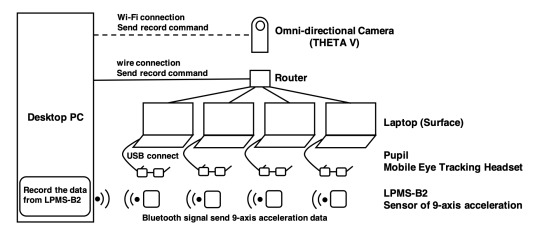
Multimodal Recording System for Collecting Facial and Postural Data in a Group Meeting
27th International Conference on Computers in Education (ICCE '19), pp.466-471, Kenting, Taiwan, December 4-6, 2019. Yusuke Soneda, Yuki Matsuda, Yutaka Arakawa and Keiichi Yasumoto
Abstract: By the spread of active learning and group work, the ability to collaborate and discuss among the participants becomes more important than before. Although several studies have reported on that micro facial expressions and body movements give psychological effects to others during conversation, most of them are lacking in quantitative evaluation and there are few datasets about group discussion. In this research, we proposed a highly reproducible system that helps to make datasets of group discussions with multiple devices such as an omnidirectional camera (360-degree camera), an eye tracker and a motion sensor. Our system operates those devices in one-stop to realizing synchronized recording. To confirm the feasibility, we built the proposed system with an omnidirectional camera, 4 eye trackers, and 4 motion sensors. Finally, we succeeded to make a dataset by recording 8 times group meeting by using our developed system easily.
Conference: http://ilt.nutn.edu.tw/icce2019/
#meeting#discussion#DisCaaS#M3B Corpus#eye gaze#360camera#omnidirectional camera#behavior analysis#activity recognition#NAIST#conference#english#publication
0 notes
Photo
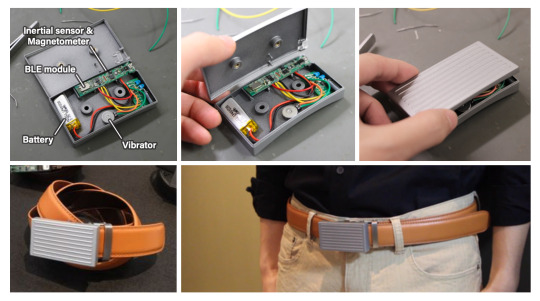
WaistonBelt X: A Belt-Type Wearable Device with Sensing and Intervention Toward Health Behavior Change
Sensors 2019, Vol.19, No.20:4600, 2019. Yugo Nakamura, Yuki Matsuda, Yutaka Arakawa and Keiichi Yasumoto
Abstract: Changing behavior related to improper lifestyle habits has attracted attention as a solution to prevent lifestyle diseases, such as diabetes, heart disease, arteriosclerosis, and stroke. To drive health behavior changes, wearable devices are needed, and they must not only provide accurate sensing and visualization functions but also effective intervention functions. In this paper, we propose a health support system, WaistonBelt X, that consists of a belt-type wearable device with sensing and intervention functions and a smartphone application. WaistonBelt X can automatically measure a waistline with a magnetometer that detects the movements of a blade installed in the buckle, and monitor the basic activities of daily living with inertial sensors. Furthermore, WaistonBelt X intervenes with the user to correct lifestyle habits by using a built-in vibrator. Through evaluation experiments, we confirmed that our proposed device achieves measurement of the circumference on the belt position (mean absolute error of 0.93 cm) and basic activity recognition (F1 score of 0.95) with high accuracy. In addition, we confirmed that the intervention via belt vibration effectively improves the sitting posture of the user.
MDPI Sensors: https://www.mdpi.com/1424-8220/19/20/4600
PDF: http://yukimat.jp/data/pdf/paper/WaistonBelt_j_201911_yugontech_mdpiSensors.pdf
0 notes
Photo

M3B Corpus: Multi-Modal Meeting Behavior Corpus for Group Meeting Assessment
Adjunct Proceedings of the 2019 ACM International Joint Conference on Pervasive and Ubiquitous Computing (UbiComp '19 Adjunct, HASCA Workshop), pp.825-834, London, United Kingdom, September 10, 2019. Yusuke Soneda, Yuki Matsuda, Yutaka Arakawa and Keiichi Yasumoto
Abstract: This paper is the first trial to create a corpus on human-to-human multi-modal communication among multiple persons in group discussions. Our corpus includes not only video conversations but also the head movement and eye gaze. In addition, it includes detailed labels about the behaviors appeared in the discussion. Since we focused on the micro-behavior, we classified the general behavior into more detailed behaviors based on those meaning. For example, we have four types of smile: response, agree, interesting, sympathy. Because it takes much effort to create such corpus having multiple sensor data and detailed labels, it seems that no one has created it. In this work, we first attempted to create a corpus called ''M3B Corpus (Multi-Modal Meeting Behavior Corpus),'' which includes 320 minutes discussion among 21 Japanese students in total by developing the recording system that can handle multiple sensors and 360-degree camera simultaneously and synchronously. In this paper, we introduce our developed recording system and report the detail of M3B Corpus.
Conference (HASCA): http://hasca2019.hasc.jp/
Conference (UbiComp): http://ubicomp.org/ubicomp2019/
ACM Digital Library: https://doi.org/10.1145/3341162.3345588
PDF: https://dl.acm.org/doi/pdf/10.1145/3341162.3345588
#meeting#discussion#DisCaaS#M3B Corpus#eye gaze#360camera#omnidirectional camera#behavior analysis#activity recognition#NAIST#conference#english#publication
0 notes
Text
Started Working at NAIST
Assistant Professor at Ubiquitous Computing Systems Laboratory, NAIST, Japan.
0 notes
Photo
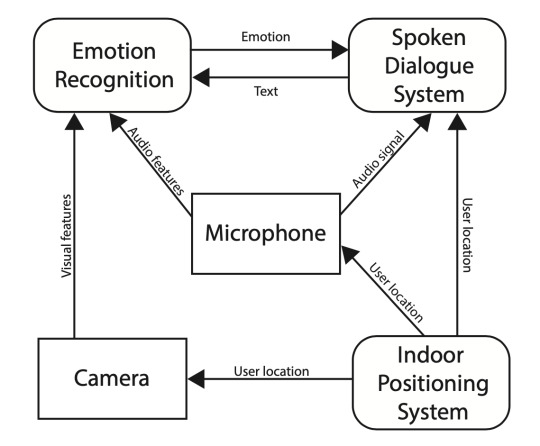
From Smart to Personal Environment: Integrating Emotion Recognition into Smart Houses
2019 IEEE International Conference on Pervasive Computing and Communications Workshops (PerCom Workshops '19, PerDial), pp.943-948, Kyoto, Japan, March 15, 2019. Dmitrii Fedotov, Yuki Matsuda and Wolfgang Minker
Abstract: Recent advances in computational and sensing technologies allowed to incorporate different devices into a smart systems, making the ubiquitous or pervasive computing a hot topic for research and commercial projects. One technology, that can help the user to interact with invisible system representing smart environment is spoken dialogue system. Following the success in research on automatic speech recognition and natural language understanding, spoken dialogue systems have significantly improved themselves during the past decade and now bringing the communication between human and machine closer to natural level. Having user as a main subject, both system may benefit from explicit information about his current state and mood, adjusting their behaviour to the certain extent. In this paper we consider the combination of ubiquitous computing, spoken dialogue systems, and emotion recognition technologies, suggest possible ways of information flow, discuss future applications and potential problems. We find, that these technologies can be complementary to each other, increasing their flexibility, robustness and intelligibility when combined. We present the usage of such approach in a smart house environment, continuously tracking the state of the user, interacting with them in real time and reacting to mood changes.
Conference: http://www.percom.org/Previous/ST2019/
IEEE Xplore: https://doi.org/10.1109/PERCOMW.2019.8730876
#emotion#emotion recognition#audio-visual data#smart home#dialogue system#NAIST#UUlm#conference#english#publication
0 notes
Photo

Towards Real-Time Contextual Touristic Emotion and Satisfaction Estimation with Wearable Devices
Demo, 2019 IEEE International Conference on Pervasive Computing and Communications Workshops (PerCom Workshops '19), pp.358-360, Kyoto, Japan, March 12, 2019. Dmitrii Fedotov, Yuki Matsuda, Yuta Takahashi, Yutaka Arakawa, Keiichi Yasumoto and Wolfgang Minker
Abstract: Following the technical progress and growing touristic market, demand on guidance systems is constantly increasing. Current systems are not personalized, they usually provide only a general information on sightseeing spot and do not concern about the tourist's perception of it. To design more adjustable and context-aware system, we focus on collecting and estimating emotions and satisfaction level, those tourists experience during the sightseeing tour. We reducing changes in their behaviour by collecting two types of information: conscious (short videos with impressions) and unconscious (behavioural pattern recorded with wearable devices) continuously during the whole tour. We have conducted experiments and collected initial data to build the prototype system. For each sight of the tour, participants provided an emotion and satisfaction labels. We use them to train unimodal neural network based models, fuse them together and get the final prediction for each recording. As tourist himself is the only source of labels for such system, we introduce an approach of post-experimental label correction, based on paired comparison. Such system built together allows us to use different modalities or their combination to perform real-time tourist emotion recognition and satisfaction estimation in-the-wild, bringing touristic guidance systems to the new level.
Conference: http://www.percom.org/Previous/ST2019/
IEEE Xplore: https://doi.org/10.1109/PERCOMW.2019.8730864
#EmoTour#psychological state#emotion#satisfaction#wearable devices#NAIST#conference#english#publication
0 notes
Photo
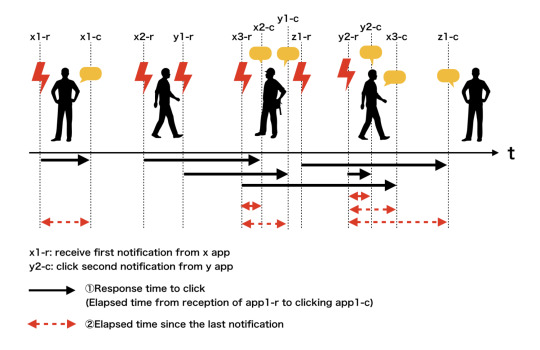
Design and Implementation of Notification Information Survey System and Survey Results Toward Use-side Adaptive Notification Management
2019 IEEE International Conference on Pervasive Computing and Communications Workshops (PerCom Workshops '19, PerPersuasion), pp.808-813, Kyoto, Japan, March 11, 2019. Kenta Taki, Yuki Matsuda, Yutaka Arakawa and Keiichi Yasumoto
Abstract: Many interrupt notification methods have been studied, but most of the existing research assumes that, except for the target application, the applications do not control the notification timing. However, if other applications are controlled by the same notification timing, interrupt timing will become concentrated and the effects of notification timing control may not be exerted. In addition, since the installed applications are different for each user, it is necessary to control notification timings while taking into consideration the behaviors of all the applications installed on a user's smartphone. In this research, we define notification timing control while considering the behaviors of all installed applications as ''Adaptive Notification Management'' and then conduct diversity surveys of notifications received by users. In this paper, we report on a system that acquires all notification information while excluding privacy data. We also report on experimental results using actual data collected using crowdsourcing and discuss how to realize the application realizing adaptive notification management.
Conference: http://www.percom.org/Previous/ST2019/
IEEE Xplore: https://doi.org/10.1109/PERCOMW.2019.8730694
0 notes
Photo
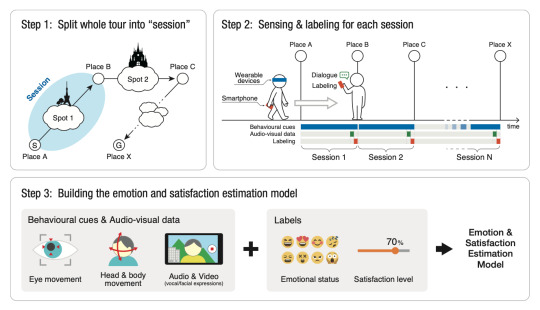
EmoTour: Estimating Emotion and Satisfaction of Users Based on Behavioral Cues and Audiovisual Data
Sensors 2018, Vol.18, No.11:3978, 2018. Yuki Matsuda, Dmitrii Fedotov, Yuta Takahashi, Yutaka Arakawa, Keiichi Yasumoto and Wolfgang Minker
Abstract: With the spread of smart devices, people may obtain a variety of information on their surrounding environment thanks to sensing technologies. To design more context-aware systems, psychological user context (e.g., emotional status) is a substantial factor for providing useful information in an appropriate timing. As a typical use case that has a high demand for context awareness but is not tackled widely yet, we focus on the tourism domain. In this study, we aim to estimate the emotional status and satisfaction level of tourists during sightseeing by using unconscious and natural tourist actions. As tourist actions, behavioral cues (eye and head/body movement) and audiovisual data (facial/vocal expressions) were collected during sightseeing using an eye-gaze tracker, physical-activity sensors, and a smartphone. Then, we derived high-level features, e.g., head tilt and footsteps, from behavioral cues. We also used existing databases of emotionally rich interactions to train emotion-recognition models and apply them in a cross-corpus fashion to generate emotional-state prediction for the audiovisual data. Finally, the features from several modalities are fused to estimate the emotion of tourists during sightseeing. To evaluate our system, we conducted experiments with 22 tourists in two different touristic areas located in Germany and Japan. As a result, we confirmed the feasibility of estimating both the emotional status and satisfaction level of tourists. In addition, we found that effective features used for emotion and satisfaction estimation are different among tourists with different cultural backgrounds.
MDPI Sensors: http://www.mdpi.com/1424-8220/18/11/3978
PDF: http://yukimat.jp/data/pdf/paper/EmoTour_j_201811_yukimat_mdpiSensors.pdf
#EmoTour#wearable devices#emotion#sightseeing#satisfaction#psychological state#NAIST#IoT#english#journal#publication#UUlm
0 notes